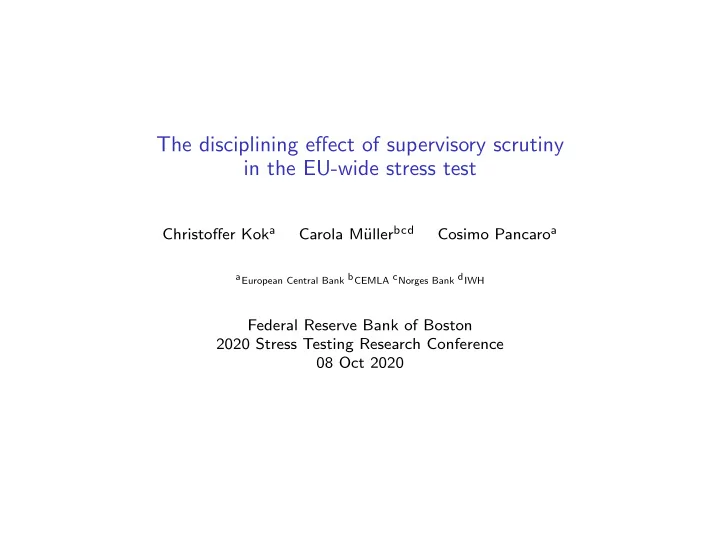

The disciplining effect of supervisory scrutiny in the EU-wide stress test Christoffer Kok a uller bcd Cosimo Pancaro a Carola M¨ aEuropean Central Bank bCEMLA cNorges Bank dIWH Federal Reserve Bank of Boston 2020 Stress Testing Research Conference 08 Oct 2020
Motivation This paper looks behind the curtain of stress testing and sheds light on the effects of supervisory scrutiny ◮ Earlier work shows stress testing can affect bank risk [Acharya/Berger/Roman, 2018; Steri/Pierret, 2018, Cort´ es et al., 2020] ? Does supervisory scrutiny play a role? ◮ A great deal of stress testing is confidential between supervisors and supervised banks, e.g. communications about best-practice and stress testing techniques ? Do risk management capabilities built up for compliance purposes spill over into bank outcomes? ◮ Supervisory efforts can have a disciplining effect on banks [Hirtle/Kovner/Plosser, 2019; Kandrac/Schlusche, 2019] ? Do they in stress testing? European Central Bank, CEMLA Christoffer Kok, Carola M¨ uller, Cosimo Pancaro 1/5
What we do in this paper ◮ We investigate whether the supervisory scrutiny associated with the EU-wide stress tests has an effect on bank credit risk European Central Bank, CEMLA Christoffer Kok, Carola M¨ uller, Cosimo Pancaro 2/5
What we do in this paper ◮ We investigate whether the supervisory scrutiny associated with the EU-wide stress tests has an effect on bank credit risk • YES! The more scrutiny banks receive during a stress test exercise, the more they reduce credit risk. 7330 .05 0 −.05 −.1 −.15 p(0) p(20) p(40) p(60) p(80) p(100) Marginal effects of supervisory scrutiny on credit risk. European Central Bank, CEMLA Christoffer Kok, Carola M¨ uller, Cosimo Pancaro 2/5
What we do in this paper ◮ We investigate whether the supervisory scrutiny associated with the EU-wide stress tests has an effect on bank credit risk ◮ We study the 2016 EU-wide stress test in a diff-in-diff setting Results Announcement Launch Launch published Q1 Q2 Q3 Q4 Q1 Q2 Q3 Q4 Q1 Q2 Q3 Q4 2015 2016 2017 Post ST16 = 0 Post ST16 = 1 • 63 Tested SIs — 69 Non-tested LSIs European Central Bank, CEMLA Christoffer Kok, Carola M¨ uller, Cosimo Pancaro 2/5
What we do in this paper ◮ We investigate whether the supervisory scrutiny associated with the EU-wide stress tests has an effect on bank credit risk ◮ We study the 2016 EU-wide stress test in a diff-in-diff setting • Risk is measured as risk weight density (RWD) for credit risk exposures Risk-Weighted Credit Risk Exposures i , t RWD i , t = Total Credit Risk Exposure i , t European Central Bank, CEMLA Christoffer Kok, Carola M¨ uller, Cosimo Pancaro 2/5
What we do in this paper ◮ We investigate whether the supervisory scrutiny associated with the EU-wide stress tests has an effect on bank credit risk ◮ We study the 2016 EU-wide stress test in a diff-in-diff setting ◮ We explore the role of supervisory scrutiny • The European design allows us to highlight the effect of supervisory scrutiny in contrast to other channels • European stress test results do not necessarily lead to capital measures (profit distribution limits, capital requirements) • We construct three metrics of supervisory scrutiny in the EU stress test ⇒ Today I focus only on one metric European Central Bank, CEMLA Christoffer Kok, Carola M¨ uller, Cosimo Pancaro 2/5
Stress test design and supervisory scrutiny metrics The EU-wide stress test follows a Constrained Bottom-Up approach: ◮ Banks use their own models to generate stress test projections ◮ The ECB and banks interact during the Quality Assuarance (QA) between launch and publication of the stress test results ◮ The ECB mainly use two challenger approaches to ensure the credibility of banks’ projections Comparison Deviation Communication of bank submission and automated, if material If ass. as meaningful raises a flag to the bank challenger models Simplified cycle of the ECB Quality Assurance process. ◮ High QA Quantity : Above-median number of communicated flags on credit risk European Central Bank, CEMLA Christoffer Kok, Carola M¨ uller, Cosimo Pancaro 3/5
Main Finding: Effect of supervisory scrutiny on credit risk RWD i , t = β 1 ( Post ST16 t × Tested i ) + β 3 X i , t − 1 + α i + γ t + δ t , j + ǫ i , t + β 2 ( Post ST16 t × Tested i × High Scrutiny i ) Supervisory Capital Baseline Both Scrutiny Structure Post x Tested -0.042** -0.014 -0.054** -0.008 (0.019) (0.016) (0.021) (0.021) Post x Tested x High QA Quantity -0.056*** -0.055*** (0.020) (0.020) Post x Tested x High Capital Guidance 0.028 0.011 (0.023) (0.020) Observations 924 924 924 924 within-R2 0.132 0.155 0.127 0.152 ◮ Banks with higher stress test intensity in form of high supervisory scrutiny reduce credit risk European Central Bank, CEMLA Christoffer Kok, Carola M¨ uller, Cosimo Pancaro 4/5
Conclusions ◮ We find that the 2016 European Stress Test exercise impacted SSM banks behaviour ◮ Higher supervisory scrutiny disciplines tested banks more ◮ Banks that had more interactions with the supervisor reduced their RWD more than banks that received less treatment. � The scrutiny effect persists in a subsample of tested banks � The scrutiny effect is independent of stress-test related capital effects ◮ Stress test design and stress test effects interact European Central Bank, CEMLA Christoffer Kok, Carola M¨ uller, Cosimo Pancaro 5/5
Recommend
More recommend